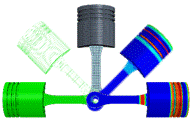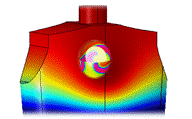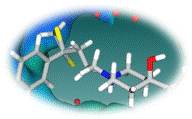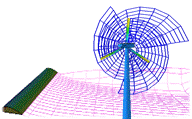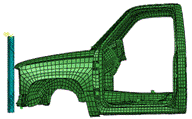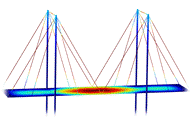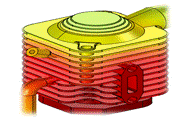ADVANCED MATERIAL DESIGN SOLUTIONS
Materials are the main enablers for business innovation even at this digital age. The importance of materials technology is evident from the naming of human evolution after materials. Advanced material is one of focus area for ATOA’s Research and innovation. We scan the scientific discoveries for material innovation opportunity. We leverage our computational material mechanics expertise for accelerating scientific discovery into material to product innovations.
Multiphysics engineered material development, which leverage convergence of Multiphysics, structural, thermal, flow, acoustics, optical and Electromagnetics is the current trend in engineering simulation based virtual material development. Material Unity is the emerging trend, which is convergence of nano, bio, info and Cognitive science (NBIC) for future material technology development. This can change the way we develop new material and products and connected devices.
ATOA Scientific Technologies, have in-depth experience in various engineering materials. The engineering services at ATOA, specific to materials span from the raw material to production process to application development to life performance prediction. We research advanced materials and process design solution under core, composites and emerging materials category. Core metal, Ceramic and polymer materials and their composite are relatively matured and is offered under Material Design solutions. Our Research and innovation focus is on material and application design based on emerging material technologies, smart, Nano and metamaterials. We have developed computational tools to model the behaviour of these materials for innovative products and device development.
Smart Materials
Smart materials allows us to leverage, shape memory, self sensing, self healing, Piezoelectric, Magnetostrictive, Halochromic, Chromogenic, Ferrofluid, Photomechanical, Magnetocaloric and Thermoelectric effects for intelligent applications. We have developed materials models to capture the constitutive behaviour of these materials for novel application development. Structural health monitoring of automobile, aircraft and building, self healing composite and concretes, Energy harvesting devices leveraging Piezoelectric, Magnetostrictive and thermoelectric effects are under smart materials focus.
Nanomaterials
Materials engineered at nanometer length scales allows us to develop nanomaterials with superior properties for superior application performance. At nanometer length scale the gravitational vs electromagnetic forces, volume vs surface properties, wave particle effects, tunnelling, quantum confinement and quantisation of energy effects dominate. Engineering at nanometer length scale can leverage these effects for superior properties which are not generally available at macro scale design. Stiff and tough Nanocomposites, Nano foam for super insulation, Nano dielectrics for
Metamaterials
Metamaterial takes us to next level to engineering materials with unusual properties which does not exist in nature by combining existing natural materials. These properties can be engineered from the existing natural materials as these properties are derived from the structure, analogues to atomic arrangement in crystal lattice. Electromagnetic, acoustic and elastic metamaterials are under development leveraging, unusual negative refractive index, index matching, band gap, clocking, resonance, frequency shift, inverse doppler shift, GOOS-HANCHEN shift and plasmonics for novel applications. Some of novel application under development are, antennas, medical imaging, medical therapy, clocking, anti reflection coating and energy absorbers.
Bio Active Materials
Active matter is the new growth trend in computational material mechanics modelling. Early Biomaterials required to be biologically inert to replace human body tissues with synthetic materials. New Generation of biomaterial needs to be bioactive. Bio active materials respond to their environment. On the computational modelling, predicting the performance of active material or matter is growing. Along with the growth of smart materials, the future biomaterials needs to smart or intelligent. Bio materials which are active and smart will be future need for advanced biomaterials development. This requirement we believe will be fulfilled with BioCAE of materials, Computational modelling of bioactive materials. This is an active focus area at ATOA research and Innovation for active biomaterials, tissue Engineering, 3D printing of biomaterials.
Advanced Materials Processing
Raw materials are converted into basic building block for engineering application through various manufacturing processes and depends on the type of materials. Material structures, process temperature and chemical/physical behaviour dominates the material processability. New developments in nano and meta composites requires novel manufacturing methods like self assembly and nanoscale 3D printing. We explore material simulation methodology for efficient, cost effective and faster processing of materials with engineering microstructure or morphology. We specialise also on energy efficient material processing using electromagnetic (DC, AC, IR, RF, MW) , induction heating and bio inspired manufacturing methods.
In order to develop unique material, we need to engineer constituent properties, interface behavior, and the microstructure or morphology. The macro properties are rooted from the constituent property and interaction. The response of a composite structure initiates from atomic level to molecular to morphology to constituents to macro properties. Tailoring these parameters through simulations can help to design material with better properties by factoring the constituent effects and interaction. This technology development enables digital design of materials to engineer Impact, Moduli, magnetic, conductive and dielectric properties for novel engineering applications. Contact us for your advanced material, process and application development needs at http://cae.atoa.com/contact-resources/contact-form .

